|
|
The Holy Martyr Charitina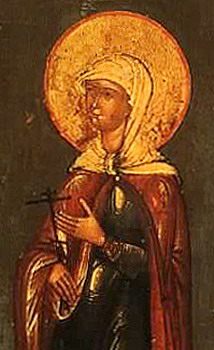 Orphaned young, she was adopted by an eminent Christian man called Claudius, who brought her up as his own daughter. Charitina was meek, humble, obedient and silent. She studied the law of God day and night and vowed to live in perpetual virginity as a true bride of Christ. But, Charitina having brought others to the Christian faith, the Emperor Diocletians"s governor, Dometius, heard of her and sent soldiers to take her from her foster-father for trial. The judge asked her: "Is it true, little girl, that you are a Christian, and that you delude others by bringing them to this dishonourable faith?" Charitina courageously replied: "It is true that I am a Christian, and a lie that I delude others. I lead those in error to the way of truth, bringing them to my Christ." The wicked judge ordered that her hair be cut off and live coals put on her head, but the maiden was preserved by God"s power. They threw her into the sea, but God delivered her from it. She was bound to a wheel which began to turn, but an angel of God stopped the wheel and Charitina remained unharmed. Then the wicked judge sent some dissolute youths to rape her. Fearing this dishonour, St Charitina prayed to God to receive her soul before these dissolute men could foul her virginal body and so, while she was kneeling in prayer, her soul went out from her body to the immortal Kingdom of Christ. Orphaned young, she was adopted by an eminent Christian man called Claudius, who brought her up as his own daughter. Charitina was meek, humble, obedient and silent. She studied the law of God day and night and vowed to live in perpetual virginity as a true bride of Christ. But, Charitina having brought others to the Christian faith, the Emperor Diocletians"s governor, Dometius, heard of her and sent soldiers to take her from her foster-father for trial. The judge asked her: "Is it true, little girl, that you are a Christian, and that you delude others by bringing them to this dishonourable faith?" Charitina courageously replied: "It is true that I am a Christian, and a lie that I delude others. I lead those in error to the way of truth, bringing them to my Christ." The wicked judge ordered that her hair be cut off and live coals put on her head, but the maiden was preserved by God"s power. They threw her into the sea, but God delivered her from it. She was bound to a wheel which began to turn, but an angel of God stopped the wheel and Charitina remained unharmed. Then the wicked judge sent some dissolute youths to rape her. Fearing this dishonour, St Charitina prayed to God to receive her soul before these dissolute men could foul her virginal body and so, while she was kneeling in prayer, her soul went out from her body to the immortal Kingdom of Christ.The Hieromartyr Dionysius, Bishop of Alexandria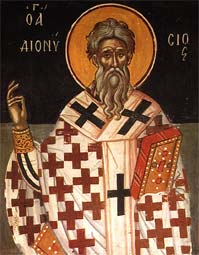 Born in Alexandria of eminent, pagan parents, he was educated in Hellenic philosophy and then studied with Origen. As a young man, he read St Paul"s epistles, came to faith in Christ and was baptised by Dimitrios, the then Bishop of Alexandria. He himself became bishop there in 247, and served God and the people of God as a true pastor in very difficult circumstances. The Church was outwardly persecuted by pagans and inwardly split by heretics. There were also the effects of a plague, that weakened the people for several years. He lived for three years outside Alexandria, hidden by the faithful, that he should not be killed before his time. In those three years, he wrote many epistles and other works for his flock, instructing them and encouraging them in the upholding of Orthodoxy. Among his writings are a few canons which were adopted by the Church, and his letter against Novatius is also regarded as a canonical writing. He governed the Church for seventeen years, and entered into rest in 265. Born in Alexandria of eminent, pagan parents, he was educated in Hellenic philosophy and then studied with Origen. As a young man, he read St Paul"s epistles, came to faith in Christ and was baptised by Dimitrios, the then Bishop of Alexandria. He himself became bishop there in 247, and served God and the people of God as a true pastor in very difficult circumstances. The Church was outwardly persecuted by pagans and inwardly split by heretics. There were also the effects of a plague, that weakened the people for several years. He lived for three years outside Alexandria, hidden by the faithful, that he should not be killed before his time. In those three years, he wrote many epistles and other works for his flock, instructing them and encouraging them in the upholding of Orthodoxy. Among his writings are a few canons which were adopted by the Church, and his letter against Novatius is also regarded as a canonical writing. He governed the Church for seventeen years, and entered into rest in 265.Our Holy Father Eudocimus of Vatopedi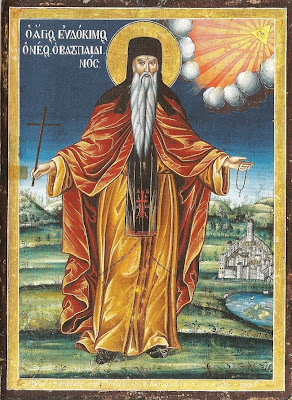 In 1841, when the bone-chapel at Vatopedi was being restored, workmen found the relics of a man kneeling and holding an icon of the Mother of God. Not knowing who this man could have been and when he had lived, the monks gave him the name Eudocimus and transferred his relics to the church, where they are preserved to this day. Many miracles of healing have been performed by them. Today the following words are carved on his coffin: "This coffin was made for the honoured head of St Eudocimus by the monk Gabriel, whom the saint healed of great sickness." In 1841, when the bone-chapel at Vatopedi was being restored, workmen found the relics of a man kneeling and holding an icon of the Mother of God. Not knowing who this man could have been and when he had lived, the monks gave him the name Eudocimus and transferred his relics to the church, where they are preserved to this day. Many miracles of healing have been performed by them. Today the following words are carved on his coffin: "This coffin was made for the honoured head of St Eudocimus by the monk Gabriel, whom the saint healed of great sickness."Our Holy Fathers Damian, Jeremiah and Matthew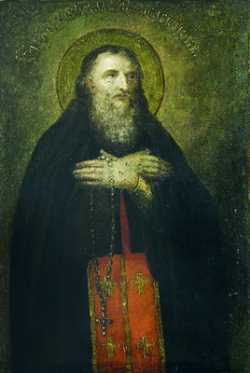 Seers and wonderworkers of the Kiev Caves, they lived in the eleventh century. Seers and wonderworkers of the Kiev Caves, they lived in the eleventh century.Martyr Mamelta (Mamelchtha) of Persia (344)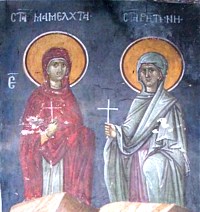 The Holy Martyress Mamelkhva the Persian before conversion to the Christian faith was a pagan priestess to the goddess Artemida.
The sister of the saint convinced her to accept Baptism. When the pagans saw Mamelkhva in the white baptismal garb, they pelted her with stones. The saint suffered in the year 344. The Holy Martyress Mamelkhva the Persian before conversion to the Christian faith was a pagan priestess to the goddess Artemida.
The sister of the saint convinced her to accept Baptism. When the pagans saw Mamelkhva in the white baptismal garb, they pelted her with stones. The saint suffered in the year 344.Venerable Jeremiah (1070) clairvoyant of the Kiev Caves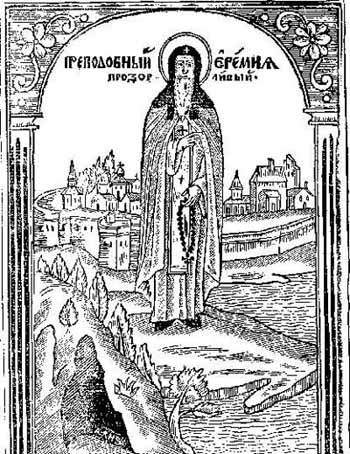 The Monk Jeremii had of the Lord the gift to see into the future, and to see into the moral condition of a person. The monk died in old age (+ c. 1070). The Monk Jeremii had of the Lord the gift to see into the future, and to see into the moral condition of a person. The monk died in old age (+ c. 1070).Venerable Matthew (1085) clairvoyant of the Kiev Caves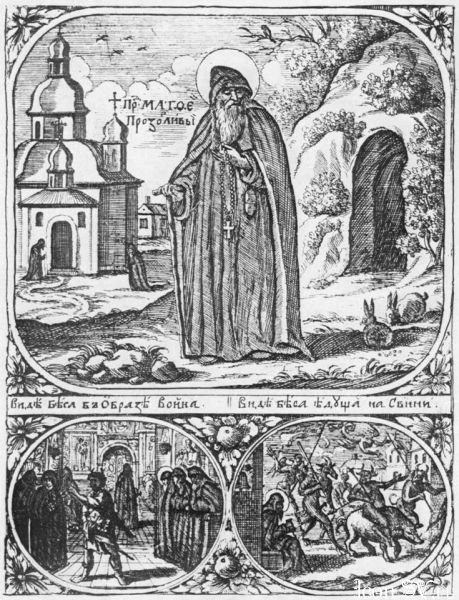 The Monk Matfei (+ c. 1088) was also endowed with the gift of seeing into the spiritual world. By his insight the elder would tell brethren, things to avoid doing of danger for the soul. In the Iconographic Original it says: "Matfei with the image of a perspicacious elder, from black greyed of beard like Vlas, in black klobuk, a monastic robe, hands pressed to the heart". The Monk Matfei (+ c. 1088) was also endowed with the gift of seeing into the spiritual world. By his insight the elder would tell brethren, things to avoid doing of danger for the soul. In the Iconographic Original it says: "Matfei with the image of a perspicacious elder, from black greyed of beard like Vlas, in black klobuk, a monastic robe, hands pressed to the heart". Venerable Cosmas, abbot in Bithynia (10th c.)Ven. Cosmas, the hegumen of the monastery on the Sangarius River, Bithynia, died in the 10th century.
Venerable Charitina, princess of Lithuania (1281)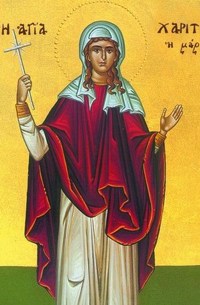 The Nun Kharitina, Princess of Lithuania, pursued asceticism in a Novgorod women's monastery in honour of the holy apostles Peter and Paul, built in Sinich hill. Having resolved to dedicate her life to the Lord, she accepted monasticism. For her virtuous life the nun was made hegumeness of the monastery... The Nun Kharitina, Princess of Lithuania, pursued asceticism in a Novgorod women's monastery in honour of the holy apostles Peter and Paul, built in Sinich hill. Having resolved to dedicate her life to the Lord, she accepted monasticism. For her virtuous life the nun was made hegumeness of the monastery...Venerable Methodia of Cimola (1908)She was born in 1865 on the island of Cimola. Against her own wishes, her parents married her to a sailor, but he drowned soon after their wedding. Though she grieved for him, she also took his loss as a sign that she was to follow the path that she had always most deeply desired — so she entered monastic life, receiving the name Methodia...
Venerable Gregory (Grigol) the Archimandrite of Chandzoe in Klarjeti, Georgia (861) 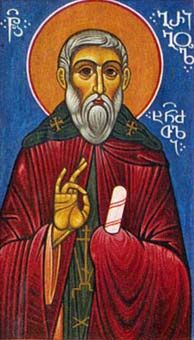 Our Holy Father Gregory of Khandzta was raised in the court of the Kartlian ruler Nerse. His family was part of the Meskhetian aristocracy. He received an education befitting his family’s noble rank and displayed a special aptitude for the sciences and theology. The youth chosen by God was extraordinarily dedicated to his studies... Our Holy Father Gregory of Khandzta was raised in the court of the Kartlian ruler Nerse. His family was part of the Meskhetian aristocracy. He received an education befitting his family’s noble rank and displayed a special aptitude for the sciences and theology. The youth chosen by God was extraordinarily dedicated to his studies...Venerable Fathers and Mothers of the Klarjeti Wilderness (9th c.)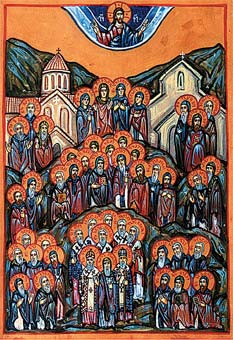 For centuries the region of Tao-Klarjeti in southwestern Georgia was known for its holiness, unity and spiritual strength. The cultural life and faith of Kartli were nearly extinguished by the Arab-Muslim domination from the 8th to 10th centuries. Tao-Klarjeti, however, which had been emptied by a cholera epidemic and the aftermath of the Islamic invasions, filled with new churches and monasteries, becoming a destination for many Christian ascetics... For centuries the region of Tao-Klarjeti in southwestern Georgia was known for its holiness, unity and spiritual strength. The cultural life and faith of Kartli were nearly extinguished by the Arab-Muslim domination from the 8th to 10th centuries. Tao-Klarjeti, however, which had been emptied by a cholera epidemic and the aftermath of the Islamic invasions, filled with new churches and monasteries, becoming a destination for many Christian ascetics... |